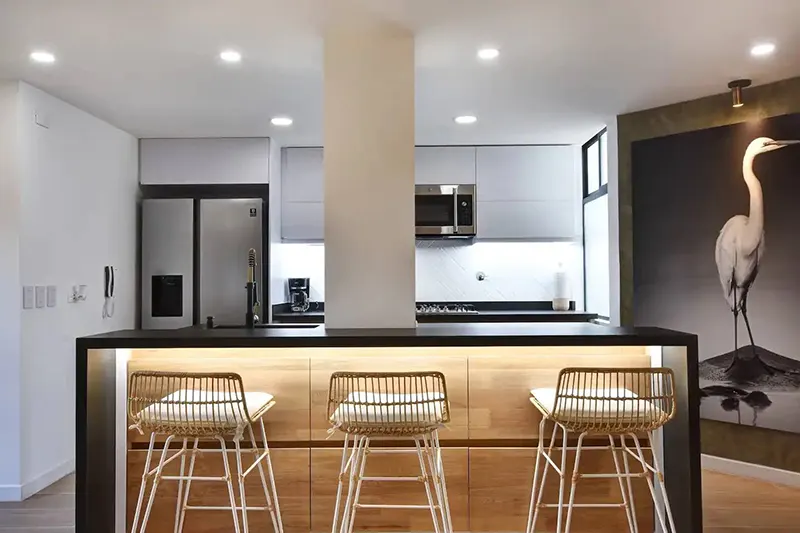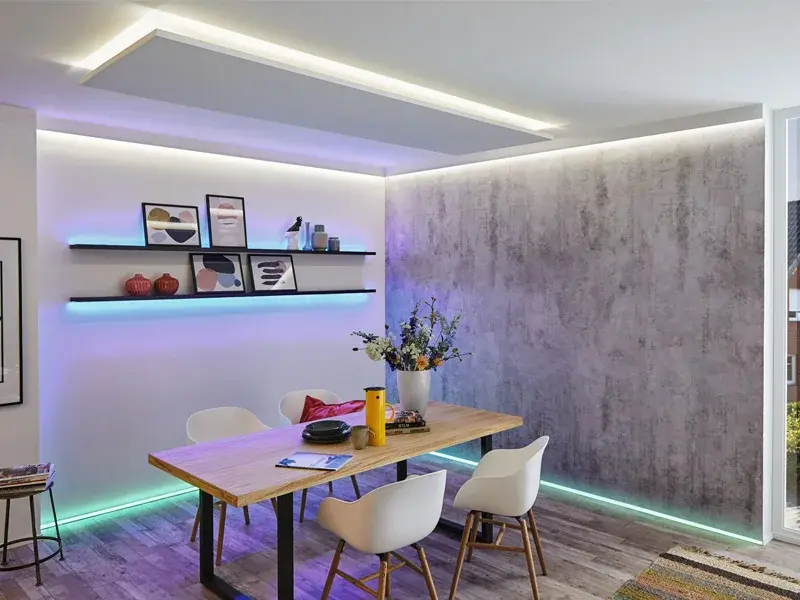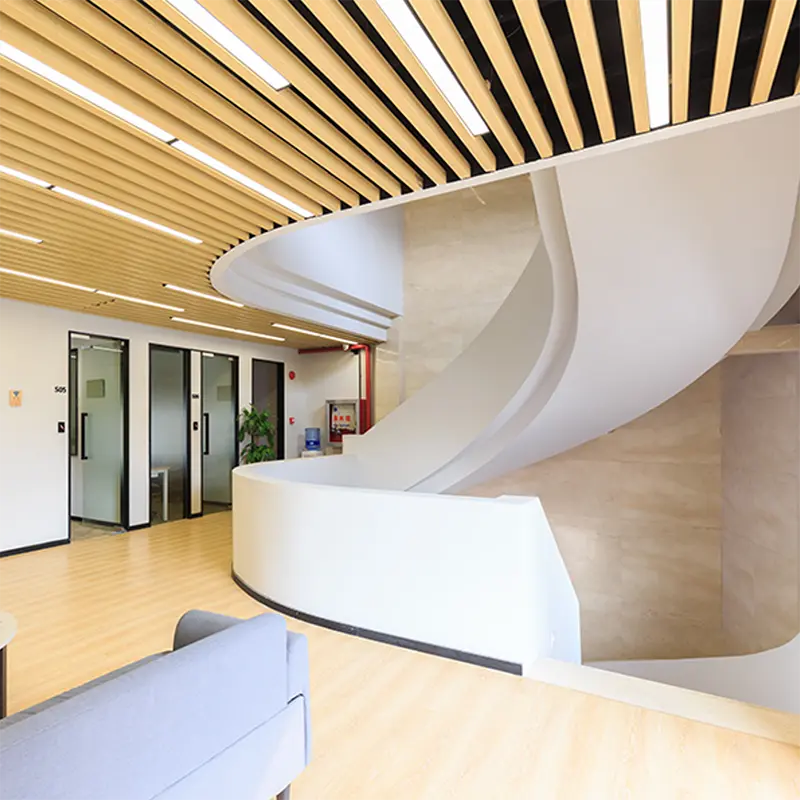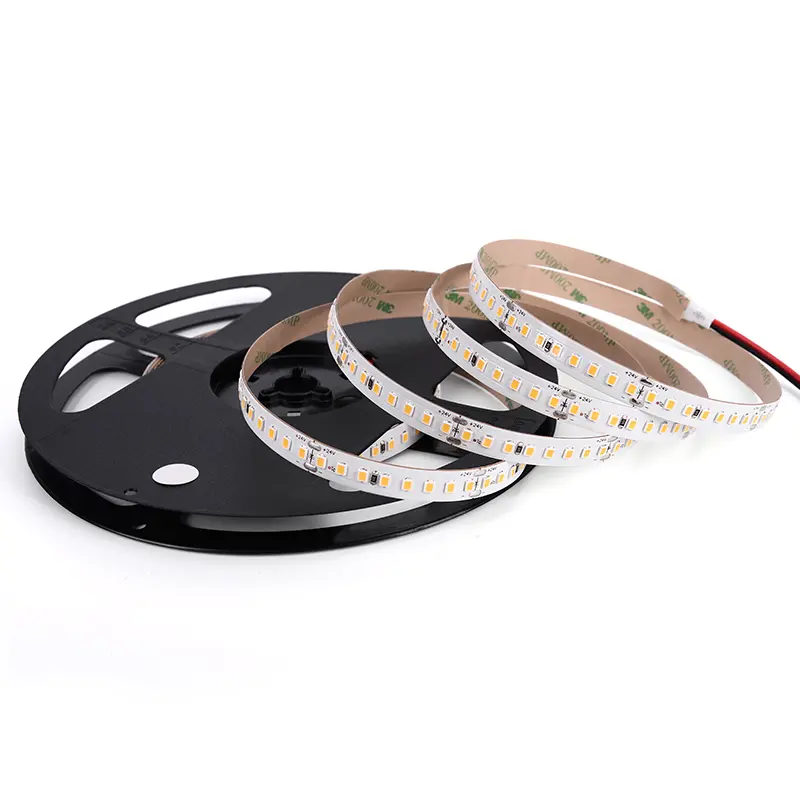Lighting does more than just provide light; it is an art that combines function and beauty. When choosing the right lighting solution, it’s important to know the differences between direct and indirect lighting.
Whether for homes, offices, or unique architectural spaces, lighting is integral in setting the mood and ensuring practicality.
This guide will provide a comprehensive understanding of direct and indirect lighting, their applications, pros, cons, and more.
Immergiamoci subito!
Understanding Lighting
Direct Lighting Definition
Definition and Use Cases
Direct lighting focuses light directly on a specific area or subject. The bright light helps with tasks that need clear vision, such as reading and cooking. Unlike indirect lighting, direct lighting focuses on a specific object or area. This gives you more control and often creates stronger contrasts. Task-oriented spaces benefit from direct lighting as it highlights the subject.
Pro e contro
Pro: Direct lighting is bright and can be adjusted with dimmers for various tasks or moods. It’s ideal for highlighting artwork or architectural features.
Contro: Improperly designed or spaced direct lighting can cause glare. It can also create unappealing shadows. Using screens for too long can strain your eyes. Bright lights can make spaces feel less cozy.
Examples: Downlights, Spotlights
Examples of direct lighting include spotlights and downlights. Spotlights often highlight certain features in a room, like artwork or architectural elements. Downlights are commonly used in places such as workspaces, kitchens, or areas that require focused lighting for tasks. You can change both options to match your preferences and make a versatile design.
What Is Indirect Lighting?
Definition and Use Cases
Unlike direct lighting, indirect lighting spreads light in the room by bouncing it off ceilings and walls. Instead of focusing on one thing, it provides overall lighting to make the space more cozy and calm. People often use it in living rooms or bedrooms when they want a softer and more relaxing light. Indirect lighting gets rid of strong shadows and makes a room look bigger.
Pro e contro
Pro: Indirect lighting evenly spreads light, making the space feel cozy and inviting. The gentle light makes the room look better by reducing strong contrasts of light and dark.
Contro: Indirect lighting may not be suitable for tasks requiring focused, sharp lighting. The light has to travel farther and bounce off more surfaces, so it might use more energy.
Examples of Indirect Light Fixtures
This category includes wall sconces, cove lighting, and pendants that reflect light indirectly. You can strategically place wall sconces to reflect light off walls. At the same time, cove lighting often runs along the edges of the ceiling to create a gentle, enveloping glow. Designers can create pendants with upward-facing shades that reflect light off the ceiling. These fixtures make the space look nice and work well. They are both useful and stylish.
In-Depth Comparison: Direct Lighting vs Indirect Lighting
Efficiency and Functionality
Consumo di energia
Both direct and indirect lighting have their unique energy consumption patterns. In certain areas, direct lighting can be very energy-efficient with LED bulbs and careful design. However, indirect lighting gives off a softer glow. It may use more energy because the light bounces off surfaces to fill the room. To save energy, choose the right bulbs, reflectors, and fixtures for different settings and preferences.
Lighting Quality
The quality of lighting differs between direct and indirect approaches. Direct lighting is ideal for tasks that require focus and attention to detail. It offers precision and control. Indirect lighting gives a soft glow that spreads evenly. This makes the room feel cozy and prevents harsh shadows and glare. Direct lighting meets specific needs, while indirect lighting improves comfort and atmosphere.
Flessibilità
In modern lighting design, flexibility is important. Direct and indirect lighting provide different options. Direct lighting can control the timing and intensity, allowing for personalized adjustments. Indirect lighting is versatile. It helps create atmosphere and fits well with the room’s style, influencing emotions. Combining these two can lead to a well-balanced and adaptable lighting environment.
Aesthetic and Design
Room Ambiance
Lighting choices greatly influence the ambiance of a room. Indirect lighting, with its soothing effect, promotes relaxation and well-being. While more intense, direct lighting can emphasize specific elements, adding character and focus. The two lighting types can change how the room feels and help with practical and decorative purposes.
Styling Possibilities
The styling possibilities are virtually endless, with both direct and indirect lighting. You can choose different designs, like bold or subtle, for direct or indirect lighting. Mixing different textures, colors, and forms can completely change the look of a room. They make the space practical and visually appealing.
Highlights Specific Elements
Highlighting specific elements within a space is an art. Direct lighting perfectly showcases art pieces or architectural details, creating drama and attention. On the other hand, indirect lighting can make things look deeper and warmer. It gently highlights textures and shapes. The strategic use of both can create a visually rich environment.
Health and Safety Considerations
Eye Strain and Comfort
Lighting has a significant impact on eye comfort. Incorrect or overly intense usage of direct lighting can strain the eyes. Indirect lighting, on the other hand, is gentler and has a calming effect. Balancing the two ensures that spaces are functional and comfortable for extended periods.
Safety Features
Safety is paramount when choosing lighting. For safe lighting, pick appropriate fixtures, follow guidelines, and consider the space’s requirements. Getting professional help and using good materials is important for preventing accidents.
Indirect Lighting vs Direct Lighting: Pros and Cons Detailed
Focus, Highlight, Safety, Aesthetic
Direct lighting is really good at making certain things stand out and keeping them safe. With careful design, it can also contribute to the overall aesthetics of a space. Indirect lighting reduces glare and creates a calm atmosphere. It enhances the visual experience with direct lighting.
Illusion of Vastness, Reduce Glare, Soothing Effect
Indirect lighting creates an illusion of space, adding a sense of vastness to a room. Many people choose it for their living areas and relaxation spaces because it reduces glare and has a soothing effect. When used with direct lighting, it creates a versatile and visually pleasing environment. It meets both functional and aesthetic needs.
Direct vs Indirect Lighting: Where and When to Use?
Direct Lighting Uses
Casa & Office, Kitchen, Museum & Art Gallery, Street Lights, For Decoration
Direct lighting is excellent in environments that require targeted, task-oriented illumination. In-home and office settings, it promotes focus for reading or working on a computer. Properly managing light in a kitchen makes it safer and more functional for cooking. Direct lighting is important in museums and art galleries. It shows artifacts well and controls highlights and shadows. Streetlights also employ direct lighting to illuminate specific paths, enhancing visibility and safety. You can use direct lighting as decoration to create captivating and dramatic effects.
Indirect Lighting Uses
Ceiling & Illuminazione a parete, mobile da cucina, bagno, automobili & Marine, Hotel & Ristoranti, progetti architettonici
L'illuminazione indiretta ha molti scopi, in primo luogo quello di enfatizzare l'atmosfera e l'illuminazione morbida. L'illuminazione indiretta a soffitto e a parete può rendere le stanze più accoglienti e invitanti. All'interno degli armadietti della cucina, offre una visibilità discreta senza abbagliamenti eccessivi. Nei bagni, l'illuminazione indiretta crea un'atmosfera rilassante, perfetta per rilassarsi. L'industria automobilistica e nautica la utilizza per rendere più confortevole la guida notturna o la navigazione. Negli alberghi e nei ristoranti crea un'atmosfera piacevole, rendendo i pasti più gradevoli. Nei progetti architettonici l'illuminazione indiretta mette in risalto le texture e crea profondità.
Utilizzo di Direct & Illuminazione indiretta insieme
Il mix di illuminazione diretta e indiretta soddisfa sia le esigenze pratiche che quelle legate all'umore. Combinando questi tipi di illuminazione, si può avere un'illuminazione precisa per i compiti e un ambiente accogliente. In un salotto, l'illuminazione diretta serve per leggere. Al contrario, l'illuminazione indiretta ammorbidisce l'atmosfera generale. Potete adattare questo mix alle vostre esigenze e creare uno spazio armonioso e vivace.
Tipi di schemi di illuminazione
Illuminazione diretta
L'illuminazione diretta, rivolta direttamente a un'area designata, offre un'illuminazione mirata. Viene utilizzata nei luoghi di lavoro e nelle mostre d'arte per aggiungere chiarezza e dettagli. Può controllare l'intensità e la direzione, rendendola utile in molte situazioni.
Illuminazione semidiretta
L'illuminazione semidiretta rappresenta un equilibrio tra messa a fuoco e diffusione. Offre una luce più morbida e chiara per attività specifiche, sia focalizzate che diffuse. Questo tipo di illuminazione è comunemente utilizzato nei luoghi in cui le persone lavorano insieme. Combina sia l'illuminazione diretta che quella indiretta.
Illuminazione indiretta
L'illuminazione indiretta crea un effetto delicato e diffuso facendo rimbalzare la luce sulle superfici. Questa luce soffusa aggiunge calore e profondità agli spazi, favorendo il relax e il benessere. È un'opzione ideale per soggiorni, hotel o luoghi che necessitano di un'atmosfera rilassante.
Illuminazione semi-indiretta
L'illuminazione semi-indiretta mescola effetti diretti e indiretti per creare una morbida miscela di luce. L'illuminazione può evidenziare caratteristiche specifiche e creare un'atmosfera accogliente. Questo approccio è versatile e può essere utilizzato in molti ambienti per raggiungere obiettivi diversi.
Illuminazione generale
L'illuminazione generale è il modo principale in cui viene illuminato uno spazio, di solito con una luce indiretta. Crea un livello di luminosità di base, assicurando la visibilità senza esagerare con l'intensità. A questo livello di base si possono aggiungere diversi tipi di illuminazione per creare una configurazione versatile. Si adatta a varie esigenze e stili.
Fare la scelta giusta
Guida alle camere
Cucina, Soggiorno, Ufficio
Ogni stanza di una casa o di un ufficio ha esigenze di illuminazione diverse. L'illuminazione diretta illumina le aree di lavoro in cucina, fornendo chiarezza alle attività culinarie. È possibile modificare l'intensità con opzioni regolabili per adattarla alle proprie esigenze culinarie. Anche gli uffici beneficiano dell'illuminazione diretta. Gli apparecchi regolabili aiutano a concentrarsi durante le ore di lavoro. L'illuminazione indiretta nei soggiorni crea un'atmosfera accogliente, ideale per rilassarsi o leggere.
Considerazioni sul budget
Costo dell'installazione
È necessario tenere presente l'aspetto finanziario dell'illuminazione. I costi di installazione possono variare notevolmente in base alla complessità e al tipo di apparecchi. L'illuminazione diretta può comportare un'installazione più complessa, con un potenziale aumento dei costi. Al contrario, semplici apparecchi di illuminazione indiretta potrebbero essere più convenienti. È consigliabile rivolgersi a un professionista per ottenere un preventivo accurato e adatto alle proprie esigenze.
Costi di manutenzione
Nel tempo, la manutenzione del sistema di illuminazione potrebbe incidere significativamente sul vostro budget. L'illuminazione indiretta ha meno parti esposte. Questo può portare a costi di manutenzione inferiori rispetto all'illuminazione diretta. Al momento di decidere, pensate a quanto sia facile prendersi cura del sistema e se durerà a lungo. Questo potrebbe farvi risparmiare in seguito.
Le migliori strategie & Suggerimenti
Analizzare la natura del progetto
Per scegliere l'illuminazione giusta, bisogna innanzitutto capire quali sono le esigenze del vostro spazio. Considerate la natura delle attività che si svolgeranno nello spazio. È più importante l'atmosfera o la funzionalità? Per scegliere l'illuminazione giusta, analizzate innanzitutto lo scopo dello spazio. Questo aiuterà a bilanciare bellezza e utilità.
Scegliere le lampadine giuste
Scegliere lampadine a LED o ad alta efficienza energetica è ecologico e garantisce prestazioni ottimali. Queste lampadine sono disponibili in diversi colori, in modo da poter regolare l'atmosfera della stanza. Le lampadine che scegliete possono influenzare notevolmente il tipo di illuminazione che desiderate. Possono creare un'atmosfera calda e accogliente o offrire una luce chiara e brillante.
Integrazione con le tecnologie intelligenti
L'adozione della tecnologia intelligente nella progettazione dell'illuminazione aggiunge livelli di convenienza ed efficienza energetica. È possibile controllare le luci da qualsiasi luogo grazie ai comandi intelligenti. È anche possibile programmare l'accensione e lo spegnimento automatico delle luci. Inoltre, le luci possono collegarsi ad altri dispositivi intelligenti. L'illuminazione intelligente facilita la regolazione delle luci in base al proprio stile di vita.
Installazione professionale o fai da te
La scelta tra l'assunzione di professionisti e il fai da te dipende dalla complessità del progetto. L'installazione professionale è sicura, di alta qualità e conforme alle normative. Il fai-da-te va bene per progetti semplici. Considerate i costi, il tempo e le competenze necessarie per prendere la decisione più adatta alle vostre esigenze.
Posizionamento degli apparecchi
Per ottenere l'effetto desiderato, posizionate le luci in modo corretto per evitare ombre e bagliori. La collaborazione con un elettricista per regolare le luci assicura che ogni parte della stanza sia ben illuminata. Posizionando le luci in modo strategico, è possibile migliorare l'aspetto e il funzionamento dello spazio. In questo modo si crea un'esperienza di illuminazione unitaria e si migliora il design.
Domande frequenti
L'illuminazione indiretta è migliore di quella diretta per gli spazi abitativi?
Non si tratta necessariamente di essere migliori degli altri, ma piuttosto di scegliere quello che più si adatta alle vostre esigenze. L'illuminazione indiretta crea un'atmosfera calda e confortevole. L'illuminazione diretta dà una luce mirata. Per creare un ambiente rilassato, le persone possono preferire l'illuminazione indiretta per i soggiorni. Tuttavia, un mix di entrambe può creare un equilibrio ideale.
È possibile utilizzare l'illuminazione indiretta all'esterno?
Sì, è possibile utilizzare l'illuminazione indiretta all'esterno per creare effetti visivi piacevoli. Si può usare per evidenziare gli elementi architettonici. Può anche creare una luce delicata nelle aree di intrattenimento all'aperto. Per ottenere apparecchi resistenti alle intemperie e una corretta installazione, è meglio rivolgersi a un professionista.
Quale illuminazione è più luminosa: diretta o indiretta?
L'illuminazione diretta è più luminosa perché si concentra su aree specifiche, fornendo una luce più forte. Al contrario, l'illuminazione indiretta diffonde la luce, dando una luminosità più morbida. La luminosità dipende anche da fattori come il tipo di lampadina e la potenza.
Come si illumina indirettamente una stanza?
Per creare un'illuminazione indiretta si possono usare gli apparecchi. Gli apparecchi fanno luce verso i soffitti o le pareti. Questa rimbalza sulle superfici, creando una luce morbida e diffusa. Per creare questo effetto, si possono usare apparecchi a incasso, applique o strisce LED indirette.
Che tipo di luce è un faretto?
Il faretto è un tipo di illuminazione diretta. Dirige la luce per mettere in risalto l'arte, l'architettura o gli artisti su un palcoscenico.
Il LED indiretto provoca danni agli occhi?
L'illuminazione LED indiretta è più facile per gli occhi perché non crea ombre o bagliori. Per garantire la sicurezza e il comfort degli occhi, è necessario considerare la qualità e il design delle lampadine LED.
What Type of Lighting is Most Efficient- Direct or Indirect?
Both types can be energy-efficient depending on the design and bulbs used. You can use LED or energy-efficient bulbs in direct or indirect lighting to save energy.
How to Identify Indirect Lighting?
Indirect lighting casts light on ceilings or walls instead of directly on objects. If the light source is hidden or spread out, it creates a soft, surrounding glow. This is called indirect lighting.
Is Light Through a Window Considered Direct Sunlight?
Direct sunlight occurs when sunlight enters a room through a window without any barriers. If the light filters through shades or reflects off other surfaces, it is more indirect.
How Can I Mix Direct and Indirect Lighting for a Harmonious Experience?
Combining direct and indirect lighting offers functional task lighting with a cozy atmosphere. Use direct lighting for tasks and indirect lighting for ambiance in specific areas. A professional consultation can tailor a perfect blend to suit your space and style.
Conclusione
Direct Lighting vs. Indirect Lighting – Which One Is Better? The answer is multifaceted and depends largely on your unique needs and environment. Both options possess distinct characteristics that make them suitable for different applications.
Areas that require focus and precision excel with direct lighting. It’s great for places where tasks are done, like kitchens and offices. It gives clear light where you need it most. Soft, gentle lighting makes a cozy atmosphere that helps you relax and unwind. To have the best lighting, consider your needs, preferences, and what each space is for.
Every space is unique, so one approach won’t work for all situations. You can talk to a lighting expert or designer to create a solution that fits your needs. They can help you pick the perfect lighting design for your home or business. They make sure it fits the architecture and interior.
Lighting is more than just light; it’s an artistic tool that shapes our spaces and emotions. Select the appropriate lighting to create a space that is both useful and appealing, tailored to your needs and preferences. Make your lights shine bright, lighting up spaces and lives, filling your world with brilliance and warmth.
Discover the future of lighting with Unitop, a top Luci a striscia LED e LED al neon flessibile maker in China. We are experts in LED lighting and can transform your space with the latest technology. If you have further questions or unique requirements, please contattateci. Let Unitop’s innovation light up your world!

Tom è ora il Direttore Vendite di Unitop (Cina) Co., Limited. È stato nella Illuminazione a LED industria dal 2005. È un esperto di vendite e marketing e di gestione della fabbrica. Gli piace il bodybuilding ed è anche un fan sfegatato di Apple! È un lavoratore instancabile e ama imparare e provare cose nuove.
Email: tom@unitopledstrip.com WhatsApp: +86-18680307140










Lascia un Commento
Vuoi partecipare alla discussione?Sentitevi liberi di contribuire!